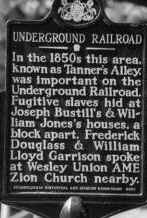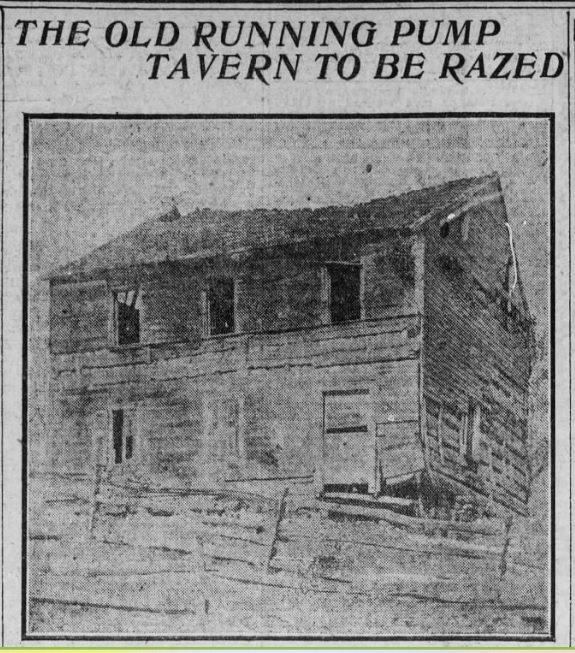
Study Areas
Anti-Slavery
1913 Description of the Joseph Meese Farm

Running Pump Tavern (Meese Farm, Linglestown, Dauphin County)
News article from the Harrisburg Daily Independent, Saturday, March 8, 1913, page 12, "The Old Running Pump Tavern to be Razed" Article written by Nevin W. Moyer and presented here as a portrait of the farm that was used as a stop on the Underground Railroad network from Harrisburg to Pottsville. This article gives a good description of the farm from someone who was born and raised there, but does not go into its association with sheltering freedom seekers in the mid-1800s
Old Running Pump Tavern
On the Running Pump farm, which bounds Linglestown, Pa., on the east and owned by the two heirs of B. F. Moyer, can be seen one of the most ancient buildings in Dauphin County.
The structure was built in 1741, according to an old deed, on a small rise of ground, in the old patent deed, dated 1765, secured from Thomas and John Penn, proprietaries and Governors-in-Chief of the province of Pennsylvania under the reign of King George III of England, it is called Mount Hill. The original parchment deed, with its great six-inch-in-diameter seal dangling from a ribbon from the bottom of the deed, and written with a quill, with its old-fashioned letters, and also with a hand of to-day busy to equal it, is in possession of Nevin W. Moyer, instructor at the Pennsylvania Training School, Morganza, Pa. He is heir of the generation who lived on the farm.
Within a stone's throw of the building are two never-failing springs. As was the custom of our forefathers always to place their buildings near to fresh water, so it was in this case. At these springs many an Indian warrior quenched his thirst and many a squaw secured water to cook the meal of corn cake, but the savage being killed or driven away the white man took charge of the eastern spring, built a spring house over it and not only used its water for drinking and cooking, but also for keeping his food fresh and wholesome in summertime.
This spring house disappeared with age, more than 100 years ago, and all that remains is its stone floor in the mud. By this time the white man saw that the western spring in the orchard could be used with better profit on account of its height for forcing its water through wooden pipes to the house, forming a running pump; hence in this way it secured its name, the Running Pump tavern. The first set of pipes was put in about 1790 and the second set in 1878. The first pipes were not rotten, but worn out where they crossed the road. At this last mentioned spring, a spring house of stone was erected, too, but age caused it to tumble thirty years ago.
The tavern originally was 50 feet by 30 feet, bit as it stands today it is a large two-story log structure 30 feet by 30 feet. The stone kitchen which was attached to the west end was torn away by Joseph Meese, grandfather to the heirs, in 1860. The stones he used in the wall of the brick house erected on the farm in 1862. The remaining stones were used in the wall which is erected in the front yard.
In entering this stone kitchen, which was torn away, you had to pass over a porch that extended the whole length of the house, or 50 feet. It's door was a double one, like that at a stable, one door above the other, so that in summer time the lower would be shut and the upper one open. There is a story told that before the Meese family owned it a man by the name of Martin Zimmerman lived there, who was a great fox hunter and had many hounds. When no hunting was being done the dogs would pass a great deal of their time in the kitchen, but when any person would pass on the road (then the road passed up between the brick house and old tavern, on up in front of the barn and then across the meadow to the town; when the field is ploughed we can very easily take notice by the stones, etc., where the old road was), the dogs on hearing the noise would leap one after the other out over the kitchen door. At the west end of this kitchen was its large hearth, which prepared many a fine meal of ham, potatoes, Johnny cake, etc., which was served by the good housewife on one of the old-fashioned four-legged tables, which was held together with wooden pins. This kitchen was two-story and just as high as the front of the main building, but the front side had only about three feet of roof, the remainder sloping to the rear. The large cellar of the house is found on the east, and when you are in it you think the north wall of this large room, where a many a good pie, cake and pudding was stored, of the olden day is the main wall of the house, it is not, for back of that there is a secret cellar 4 feet by 15 feet where the whites hid when the Indians came. The entrance to this valuable room, is through a trap door in the floor, in the closet, that is under the steps leading to the second story. The patent deed that was secured through the Penn's from King George III, of England, was granted to one Andrew Berryhill in 1765. In the Dauphin county history we find that one by the name of Andrew Berryhill lived in these parts and was murdered by the Indians. The wife and child escaped to Fort Hunter, a place of colonial protection for the colonies in these parts at Rockville, Pa. May it not have been that Andrew was living here at the time, shot while working in the field, the wife hearing the report of the rifle, looked out to see her husband a victim of the red man's gun, whereupon she may have gone with her child to this secret cellar, until all danger was gone, after the Indians had gone through the house, taking what they wanted, and left, after which she came out and started on foot with her child to Fort Hunter for safety. Many arrows, flint scalping knives and many other Indian relics have been found about this place and on the farm and can be seen in glass cases at the home of Mrs. George A. Unger, Linglestown, Pa. They were picked up and preserved by her brother, Nevin W. Moyer. In about 1850 Joseph Meese was digging at the northeast side of [the] log structure, to make a cave, when he came upon the bones of human beings, and not wanting to disturb their peaceful slumbers, the ground into its place. Now were these bones those of the red or white man, is the question. On the first floor of the log structure is one of the large old-fashioned halls, with its fine two pairs of stairs, with platform for the old grandfather clock. A case had been standing on the attic, for an unknown number of years, was there before the Meese family owned the home, and removed just a few years ago. This clock case was a treasure to the Meese children because, on Easter morn, they would always find that was where the Easter rabbit had laid its eggs. Beside the large hallway were two large rooms, in which there was many a match struck, beside the large old-fashioned firehearth, on which we hope the fire burned pleasantly through life, but we are sad to say that even the last match that was struck on any one of these rooms has gone out, because the house has not been occupied, except for storage, for more than fifty years. On the second story are three rooms one small one, and two large ones, which in winter were kept warm by two spacious hearths. In one of these hearths is still the iron upon which the crane swung whatever was cooked or boiled. The floor is of the good old-fashioned yellow pine board, fourteen and more inches wide, the partitions are of the same material, here and there, an old time wooden peg upon which to hang garments.
On the attic we see nothing but its large brown rafters, home-made shingles and the upper parts of four chimneys one for each hearth. The small house 25 feet east of the Running Pump Tavern, was erected about 1836 by Joseph Meese for his father and mother Henry Meese. Linglestown having been laid out in 1765 by Thomas Lingle, and was called the town of St. Thomas, is third to the oldest town in the county, it became the center for different great gatherings. The battalion days at Linglestown were days before the Civil war when all men between 21 and 45 met in May around it to muster, just in the township, but about May 12 the whole county would come together to be drilled and we find by research that every time that Linglestown was the fortunate spot, the Running Pump farm was chosen, excepting once. Muster day was not such an exciting day, but battalion day, people would come from all parts of the county in wagons, on horseback and walking to see its citizen soldiers drill in no uniform and with a broom stick for a gun, up to a real good rifle, very few alike. This was considered the greatest sport day there of all the year. The poor women would be under the shade tree selling cakes and pies, the old men back of a wagon selling hard cider. After the day's drill would be over the men that came from a distance would put up at the old tavern where there would be an old-fashioned dance. At these times it was often shown who was the best man with his fists. Many stories are told of the battalion days, which must be told under another subject. Oftentimes the great fights came off right in the old bar room which brings our thoughts again to the human bones buried at the northeast corner of the old house. This was the stopping place too of the old four-horse stage coach which we read about now only in history. The toot of its horn oftentimes could be heard in the distance and then in a very short time could be heard the hearty "woah" of the driver. If this house could talk, we are sure it could tell of very many noted men and women that put for a meal or lodging here. The last to drive the old four-horse stage through here was Samuel Hoover. The emigrants on their western trip in their old English covered wagon bed now mostly called the Conestoga wagon and the drovers and teamsters on their trips east or west, would have this a one of their halting places. The Yankee school teacher boarded here, who would teach school in the Locust Hill school just east of the house on the hill, on opposite side of the road, east of the little locust woods, from which the school house receives its name. In July, 1863, many a refugee from the west side of the Susquehanna had his flocks and family here. The result of the Gettysburg battle was known. Above all, we are proud that this ancient structure, sheltered many a new born babe whom our nation has been proud of, from the doctor, the minister, the lawyer, the soldier, oh! all the vocations of life. Although this house has passed many winters of great storms, its nearest threats of destruction were by fire, when the barns on the place were destroyed. The first barn that was built about the same time as the house was blown down by a cyclone in the spring of 1856. That summer Joseph Meese built another larger barn and in the fall of 1862, after all the grain was in, it was set on fire by two men paid by Jacob Poorman. Joseph Meese rebuilt it that fall, and in July 14, 1908, it was struck by lightning when full of the year's products, and in a few minutes it was in ashes. Now on the same spot stands a 102x64 foot barn, the finest and most modern in the vicinity. The original farm was over 200 acres and in about 1800 was divided and buildings put thereon, that part now being in possession of John H. Clay. This old farm is splendidly located for some industrial home, the land and buildings being in the best shape. Would love to read of some other history of house or farm of the county.
N. W. M.
 Covering
the history of African Americans in central Pennsylvania from
the colonial era through the Civil War.
Covering
the history of African Americans in central Pennsylvania from
the colonial era through the Civil War.
Support the Afrolumens Project. Read the books:
The Year of Jubilee, Volume One: Men of God, Volume Two: Men of Muscle

